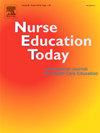沉浸式虚拟现实在护理教育:组件,结果变量和交互模式的范围审查
IF 4.2
2区 医学
Q1 EDUCATION, SCIENTIFIC DISCIPLINES
引用次数: 0
摘要
基于沉浸式虚拟现实(IVR)的护理教育提高了学习者的参与度和存在感。为了优化学习者的体验,有必要探索基于ivr的教育的各个方面。目的探讨静脉输液护理教育的影响因素、结果变量和相互作用模式,为设计有效的静脉输液护理教育提供参考。方法本综述遵循乔安娜布里格斯研究所的指南,并对Academic Search Ultimate、CINAHL、Cochrane Library、Education Source、Embase、ERIC、PubMed、Scopus和Web of Science进行了研究。纳入标准是涉及本科护理学生的研究,IVR中的虚拟患者互动,以及以英语或韩语发表的研究。排除标准是只涉及学习者与虚拟患者之间单向交流的研究。使用新世界Kirkpatrick模型对结果变量进行分类,并根据先前研究的定义对交互模式进行分类。结果纳入了自2021年以来发表的31项研究。虚拟病人代表不同的年龄组和不同的健康状况。医院、诊所、护理机构、家庭和社区的场景设置各不相同。在所有纳入的研究中,评估了新世界Kirkpatrick模型第1级(反应)或第2级(学习)的结果变量。基于控制器的交互是最常用的,而自然交互模式,如语音识别和基于手势的交互,仅在少数研究中被采用。本综述强调了基于ivr的护理教育的关键方面,包括不同的虚拟人、场景设置、结果变量和交互模式。基于这些发现,IVR为提高学习者在护理教育中的参与度和真实性提供了宝贵的机会。我们建议护理教育工作者在设计教育方案时仔细考虑IVR的组成部分和交互模式,并采用多层次的结果评估。本文章由计算机程序翻译,如有差异,请以英文原文为准。
Immersive virtual reality in nursing education: A scoping review of components, outcome variables, and interaction modes
Background
Immersive virtual reality (IVR)-based nursing education enhances learners' engagement and sense of presence. To optimize learners' experience, it is essential to explore various aspects of IVR-based education.
Objectives
This study aimed to identify the components, outcome variables, and interaction modes, and provide considerations for designing effective IVR-based nursing education.
Methods
This scoping review followed the Joanna Briggs Institute guidelines and explored Academic Search Ultimate, CINAHL, Cochrane Library, Education Source, Embase, ERIC, PubMed, Scopus, and Web of Science. The inclusion criteria were studies involving undergraduate nursing students, virtual patient interactions in IVR, and studies published in English or Korean. The exclusion criteria were studies involving only one-way communication from learners to virtual patients. Outcome variables were categorized using the New World Kirkpatrick Model, and interaction modes were classified based on definitions from previous studies.
Results
Thirty-one studies published since 2021 were included. Virtual patients represented diverse age groups and various health conditions. The scenario settings varied across hospitals, clinics, care facilities, homes, and communities. In all included studies, outcome variables at Level 1 (reaction) or Level 2 (learning) of the New World Kirkpatrick Model were assessed. Controller-based interactions were most frequently utilized, while natural interaction modes, such as speech recognition and gesture-based interactions, were employed in only a few studies.
Conclusions
This review highlights the key aspects of IVR-based nursing education, encompassing diverse virtual humans, scenario settings, outcome variables, and interaction modes. Building on these findings, IVR offers valuable opportunities to enhance learners' engagement and authenticity in nursing education. We suggest that nursing educators carefully consider the components and interaction modes of IVR and employ multiple levels of outcome evaluation when designing educational programs.
求助全文
通过发布文献求助,成功后即可免费获取论文全文。
去求助
来源期刊

Nurse Education Today
医学-护理
CiteScore
6.90
自引率
12.80%
发文量
349
审稿时长
58 days
期刊介绍:
Nurse Education Today is the leading international journal providing a forum for the publication of high quality original research, review and debate in the discussion of nursing, midwifery and interprofessional health care education, publishing papers which contribute to the advancement of educational theory and pedagogy that support the evidence-based practice for educationalists worldwide. The journal stimulates and values critical scholarly debate on issues that have strategic relevance for leaders of health care education.
The journal publishes the highest quality scholarly contributions reflecting the diversity of people, health and education systems worldwide, by publishing research that employs rigorous methodology as well as by publishing papers that highlight the theoretical underpinnings of education and systems globally. The journal will publish papers that show depth, rigour, originality and high standards of presentation, in particular, work that is original, analytical and constructively critical of both previous work and current initiatives.
Authors are invited to submit original research, systematic and scholarly reviews, and critical papers which will stimulate debate on research, policy, theory or philosophy of nursing and related health care education, and which will meet and develop the journal''s high academic and ethical standards.
 求助内容:
求助内容: 应助结果提醒方式:
应助结果提醒方式:


